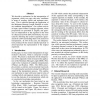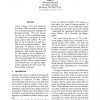1355 search results - page 218 / 271 » Bayesian networks |
TROB
2008
14 years 11 months ago
2008
Affordances encode relationships between actions, objects and effects. They play an important role on basic cognitive capabilities such as prediction and planning. We address the p...
COLING
2002
14 years 11 months ago
2002
We describe a mechanism for the interpretation of arguments, which can cope with noisy conditions in terms of wording, beliefs and argument structure. This is achieved through the...
103
click to vote
IJUFKS
2000
14 years 11 months ago
2000
Theefficiency of algorithmsfor probabilistic inference in Bayesian networks can be improvedby exploiting independenceof causal influence. Thefactorized representation of independe...
JAIR
2010
14 years 10 months ago
2010
The paper presents a scheme for computing lower and upper bounds on the posterior marginals in Bayesian networks with discrete variables. Its power lies in its ability to use any ...
103
click to vote
EMNLP
2009
14 years 9 months ago
2009
Virtual evidence (VE), first introduced by (Pearl, 1988), provides a convenient way of incorporating prior knowledge into Bayesian networks. This work generalizes the use of VE to...



